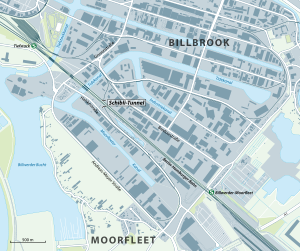Schibli tunnel
| Schibli tunnel | ||
|---|---|---|
| use | Railway tunnel | |
| place | Hamburg-Billbrook | |
| length | 106.5 m | |
| Number of tubes | 1 | |
| construction | ||
| Client | City of Hamburg | |
| start of building | 1923 | |
| completion | 1924 | |
| business | ||
| operator | AKN railroad | |
| release | around 1976 | |
| Surroundings of the Schibli tunnel | ||

|
||
| location | ||
|
|
||
| Coordinates | ||
| North portal | 53 ° 31 ′ 31 ″ N , 10 ° 4 ′ 40 ″ E | |
| South portal | 53 ° 31 ′ 28 " N , 10 ° 4 ′ 41" E | |
The Schibli Tunnel is a 106.5 meter long, single-track railway tunnel in Hamburg - Billbrook . In it, a track of the Billwerder Industriebahn crosses the tracks of the Berlin-Hamburg Bahn and the Hamburg S-Bahn (line S2 / S21).
history
After the First World War , a marshalling yard over seven kilometers long was to be built in Billwerder as part of the Hamburg freight bypass line in order to better organize freight traffic to the east. This new marshalling yard would have interrupted the connection between the Billwerder industrial railway and the Berlin-Hamburg railway at Tiefstack station, which had existed since 1907 . A tunnel was therefore planned as a new connection, which was built at the same time as the Berlin-Hamburg railway was straightened. The construction company "Gustav Schibli Kommanditgesellschaft auf Aktien", which gave the tunnel its name, built on behalf of the City of Hamburg, as the Bergedorf-Geesthacht Railway, as the operator of the industrial railway, did not want to cover the costs of a structure that would only be needed 15 years later would. During the Second World War , construction work on the freight yard was finally stopped and later not resumed due to changed traffic flows.
Because the connection to the industrial railway in Tiefstack was retained, the tunnel was not needed. The sidings on the Moorfleeter Canal and Andreas-Meyer-Straße south of the Berlin-Hamburg Railway were approached via a bridge that crossed the mainline line at the Billwerder-Moorfleet station and was part of the Hamburg Marschbahn . In the unused tunnel, the portals only about 1 m above sea level. High above sea level and thus three to four meters below the level of the artificially raised, adjacent industrial areas, there was water for decades, as the tunnel floor is around 3 meters below the water table.
The expansion of the industrial area on the Moorfleeter Canal required a change in freight traffic, which previously had to be driven over two switchbacks so that the marching railway line could be used. To simplify rail operations, the trains should now travel via Halskestrasse and through the Schibli tunnel to Tiefstack station. Therefore, in 1968/69 the tunnel got reinforced concrete troughs on both sides, which were supposed to protect against ingress of water and landslides, as well as two water pumps. In 1976, more than five decades after the tunnel was built, the city of Hamburg, the Deutsche Bundesbahn and the AKN Eisenbahn , which has operated the Billwerder industrial railway since 1956, signed a contract on the use of the structure. The bridge connection over the Billwerder-Moorfleet station was then shut down and later dismantled.
Individual evidence
- ↑ according to German basic map 1: 5000, Digitaler Atlas Nord
literature
Sven Bardua: Under the Elbe, Alster and the city. The history of tunnel construction in Hamburg. Dölling and Galitz Verlag, Munich and Hamburg 2011, ISBN 978-3-86218019-6 , pp. 87/88


